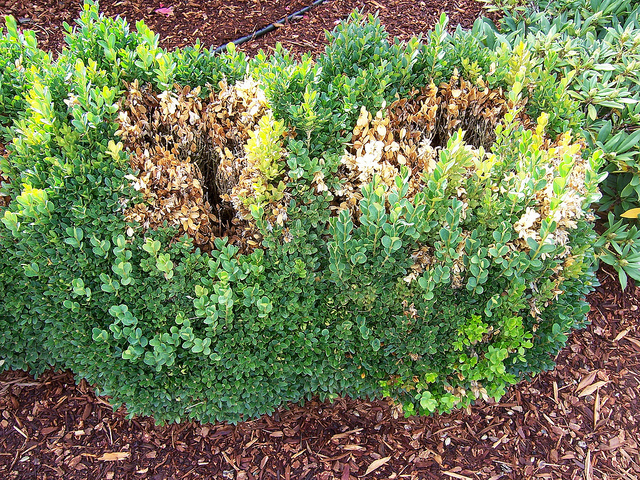When you’ve got a plant that looks a little – or a lot – in distress, don’t start trying to fix it until you know the problem.
It could be a simple glitch like not giving it enough water or putting a sun-loving plant in the shade, said Neil Bell, horticulturist with Oregon State University Extension Service. The first line of defense is knowing your plant, its characteristics and needs.
“People assume if a plant changes appearance that it’s a problem; but it may not be a problem at all,” he said. “It could be an oddball characteristic like a conifer whose foliage changes color in winter. That always worries people.”
Once a gardener came to Bell because his arborvitae hedge had turned a rusty brown color. It turns out to be its winter color. In response to cooler temperatures, some conifers change color. Some conifers have really spectacular winter color, but for arborvitae, it just looks off.
Once you’ve determined it isn’t just a characteristic of the plant and the plant is getting the sun exposure, water and nutrients it needs, it’s time to move on to solving the mystery. To do that, ask a series of systematic questions to diagnose and effectively address the cause of the malady.
“Identifying the problem first enables you to go about fixing the problem in the appropriate way,” Bell said. “Even if your problem is caused by a pest or disease, sometimes a person may choose to use a pesticide, organic or otherwise, but you have to apply it when it’s going to be effective. How people mess up is applying something that’s not needed or apply it when it doesn’t work. You don’t want to waste resources on a problem you don’t have. Sometimes people spray first and ask questions later. It should be the other way around.”
Whether you decide to diagnose your plant woes on your own or use an OSU Extension Master Gardener, the process is the same, according to Brooke Edmunds, horticulturist with OSU Extension. The trained volunteers ask the same questions and require you to come in armed with as much information as you can gather. If you don’t know what the plant is, they’ll help identify it and move down the diagnostic process to uncover the trouble.
“Sometimes people don’t know what to look for,” she said. “People notice symptoms of the plant and their eyes go right to that issue. They may see a tree with leaves that are wilting so they bring in the leaves and that’s not the issue at all. You have to look at that tree holistically. Follow it down from twig to branch to trunk to roots. The real problem may be somewhere else on the tree. Sometimes we send people back to do a walk around the tree.”
Edmunds said about 30 to 40 percent of people who approach Master Gardeners are unprepared for the questions they’ll be asked. But no one should be intimidated.
“Some people are avid gardeners, others are new,” she said. “It’s dramatically different. We get from super simple problems to some that are complex that they’ve already had other experts out for consultation. There’s no typical client.”
You can bring in samples, photographs and as much information as you can muster of the affected plant for your local Master Gardeners to examine. If coming into the office is onerous, you can email photos and information, as well. You’ll find the email address, phone number and address of your local Extension office on the website. Or submit a question and photograph to OSU Extension’s Ask an Expert service.
For more information about pests and diseases, go online to the PNW Plant Disease Management Handbook and the PNW Insect Management Handbook..
Additionally, Bell teaches a self-paced online course that’s available in fall through OSU’s Professional and Continuing Education.
“The principles of diagnosing a plant problem are very similar to going to a doctor or an auto mechanic,” Bell said. “The doctor and the auto mechanic are looking for evidence of the root of the issue.”
Bell suggested some important questions to ask as you begin your investigation:
- What’s the identity of the affected plant? Determine whether a “real” problem exists; maybe whatever the plant is doing is normal. What are the characteristics of the plant? How does it display them throughout the year?
- How many plants of the affected species are present?
- How many plants in that group are affected?
- What is the pattern of damage within the population? A uniform pattern usually indicates non-living, environmental causes of the problem. A random pattern indicates that diseases or pests could be culprits. But don’t over-analyze “uniform” versus “random.”
- Which part or parts of the plant are affected? Just the leaves, fruit, shoots, a combination of those, or the whole plant?
- What’s the pattern of damage on the leaves and stems of the individual plant? If the damage pattern is uniform or random it can often indicate the cause is non-living or caused by pests.
- What’s the pattern of damage on the plant parts?
- What time of year did the symptoms appear?
- Are the symptoms spreading, improving or constant? Pest or disease problems often become worse with time. Environmental problems in some cases look bad for a while but may start to improve.
- Are any signs of a pest present? Signs of a pest could include slug slime trails, rodent mounds or holes, fungal fruiting bodies, or distinct notches cut from the leaf margin.

